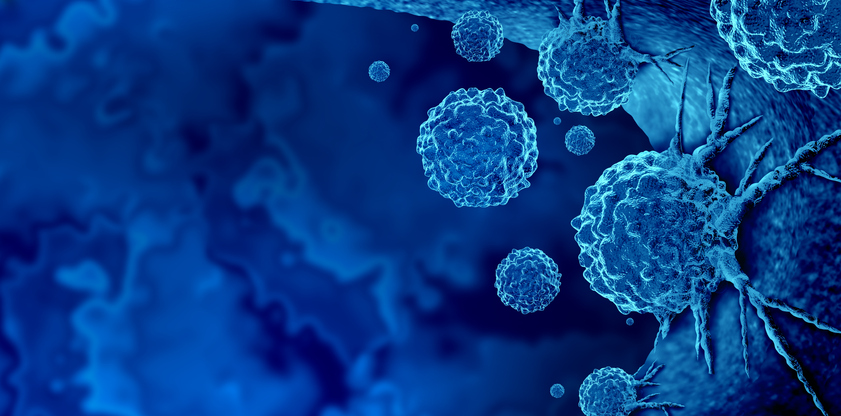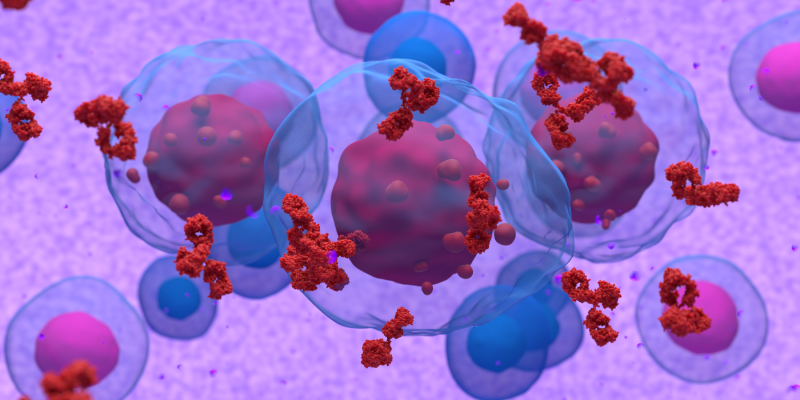
Take-aways:
- Daratumumab-based induction therapy (Dara-KRd), followed by autologous stem cell transplantation, and response-adapted consolidation led to high rates of measurable residual disease (MRD) negativity in patients with newly diagnosed multiple myeloma.
- According to the authors, Dara-KRd is safe for use as induction and post-transplant consolidation in this patient population.
- With this strategy, MRD surveillance may present an alternative to indefinite maintenance for patients with 0 or 1 high-risk cytogenetic abnormality.
Post-transplant response-adapted consolidation therapy with daratumumab, carfilzomib, lenalidomide, and dexamethasone (Dara-KRd) using measurable residual disease (MRD) led to high rates of MRD negativity in patients with newly diagnosed multiple myeloma. This is according to results from the phase II MASTER trial published in the Journal of Clinical Oncology.
“For patients with 0 or 1 high-risk cytogenetic abnormalities (HRCAs), this strategy creates the opportunity of MRD surveillance as an alternative to indefinite maintenance,” wrote the study authors, led by Luciano J. Costa, MD, from the O’Neal Comprehensive Cancer Center at the University of Alabama at Birmingham.
Patients eligible for enrollment had newly diagnosed myeloma, Eastern Cooperative Oncology Group performance status of 2 or greater, measurable paraprotein in serum or urine, and adequate hepatic, cardiac, and renal function. No hematologic parameters were required, and there was no upper age limit. In addition, the study design contained enrichment for patients with HRCAs: patients with t(4;14); t(14;16); or del(17p) accounted for at least 35% of participants.
Investigators enrolled 123 patients in 5 US states between March 2018 and October 2020. Their median age was 60 years (range, 35-79). Fifty-three patients had no HRCA, 46 had 1 HRCA, and 24 had 2 or more HRCAs.
Treatment consisted of the following phases:
- induction (cycles 1-4): daratumumab 16 mg/kg intravenously (IV) on days 1, 8, 15, and 22 (days 1 and 15 for cycles 3 and 4), carfilzomib 56 mg/m2 IV on days 1, 8, and 15 (20 mg/m2 on first dose of cycle 1); lenalidomide 25 mg orally on days 1-21; and dexamethasone 40 mg IV or orally on days 1, 8, 15, and 22
- autologous stem cell transplantation (autoSCT)
- up to 2 phases of Dara-KRd consolidation with 4 cycles each (cycles 5-8 and 9-12, respectively)
Three patients who chose to defer autoSCT instead received 4 additional cycles of Dara-KRd. Dara-KRd consolidation dose and schedule were the same as induction, except that daratumumab was administered on days 1 and 15 on cycles 5 to 6 and on day 1 on cycles 7 to 12.
The primary endpoint of the study was the achievement of MRD negativity (to a level of <10-5). MRD was assessed in 118 evaluable patients by next-generation sequencing using the clonoSEQ platform. Assessments were performed after induction, 60 to 80 days after transplant, and following the second cycle of Dara-KRd in each consolidation phase (i.e., cycles 6 and 10). Patients who achieved 2 consecutive MRD <10-5 assessments were moved to treatment-free observation and MRD surveillance at the end of that phase.
MRD surveillance involved evaluations every 8 weeks for the first 24 weeks and every 16 weeks thereafter for a total of 18 months. Physicians and their patients were encouraged to continue yearly MRD surveillance after the completion of this phase.
Overall, the median duration of treatment was 11.6 months, and the median follow-up was 23.8 months. For the 84 patients (71%) who transitioned to MRD surveillance, median therapy duration was 10.3 months and median follow-up from completing therapy and entering the MRD surveillance phase was 14.2 months. The authors noted that the 34 remaining MRD-evaluable patients either remain on therapy (n, 4), completed entire therapy without qualifying for the MRD surveillance strategy and transitioned to lenalidomide maintenance (n, 20), or discontinued prematurely (n, 10) due to death, disease progression, or withdrawal of consent.
Out of 118 MRD-evaluable patients, 38% achieved MRD <10-5 after induction, with an incrementally higher proportion reaching MRD-negative status with each phase of treatment. MRD <10-5 was achieved as best response in 80% of patients overall, including 78% of patients with 0 HRCAs, 82% in patients with 1 HRCA, and 79% in patients with 2 or more HRCAs.
At least 1 treatment-emergent adverse event (TEAE) was reported in each of the 123 patients enrolled in the study, and 74% of patients had at least 1 grade 3 to 5 TEAE. The most common TEAEs included fatigue, bone pain, neutropenia, and rash. Serious AEs were reported in 22 patients (18%) and included pneumonia (n, 8) and thromboembolic event (n, 3).
During the treatment period, 3 patients died. One patient died suddenly during the second week of induction, 1 died of metapneumovirus pneumonia during the second week post-autoSCT, and 1 died suddenly 2 months after autoSCT before starting consolidation therapy.
“Despite enrolling older patients and potentially more prolonged course of therapy, the safety profile is comparable with other series of transplant-eligible patients receiving triplet or quadruplet therapy,” the authors wrote. They added that “future studies should answer the question of whether patients who reach MRD-negativity early on therapy with quadruplets can maintain excellent outcomes without the toxicity of autoSCT and with limited-duration therapy.”
Disclosures: This research was supported by Amgen and Janssen. Study authors reported relationships with Amgen and Janssen, the manufacturers of carfilozmib and daratumumab.
Reference
Costa LJ, Chhabra S, Medvedova E, et al. Daratumumab, carfilzomib, lenalidomide, and dexamethasone with minimal residual disease response-adapted therapy in newly diagnosed multiple myeloma. J Clin Oncol. 2021 Dec 13;JCO2101935.






 © 2025 Mashup Media, LLC, a Formedics Property. All Rights Reserved.
© 2025 Mashup Media, LLC, a Formedics Property. All Rights Reserved.